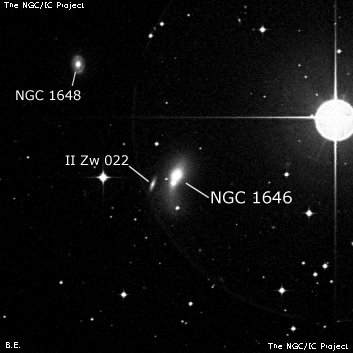
William Herschel discovered NGC 1646 = H II-523 = h329 on 30 Jan 1786 (sweep 516) and remarked "F, vS, irr R, bM, almost stellar." On 8 Jan 1831 (sweep 318), John Herschel measured an accurate position and noted "pF; R; has a *7m, 3 or 4' dist np." Robert Ball observed NGC 1646 at Birr Castle on 10 Jan 1867 and wrote, "there is one object sf and another np, one or both of which may be nebulae, but my examination was interrupted before it could be completed." The southeast object possibly refers to PGC 3084954, an extremely faint companion 0.7' SE or perhaps Ball resolved the two merged components of NGC 1646 (15" SSE of center)?
400/500mm - 17.5" (1/23/93): fairly faint, small, elongated 2:1 NW-SE, prominent small bright core, overall fairly high surface brightness. Forms the south vertex of isosceles triangle with NGC 1648 4.4' NE and 56 Eridani (V = 5.9) 4.8' WNW. The bright star detracts from viewing! A mag 11 star lies 2.1' E.
600/800mm - 24" (12/21/16): at 432x; moderately bright, fairly small, slightly elongated, ~NNW-SSE, 0.4'x0.3', high surface brightness, contains a very small bright nucleus. With averted vision a very low surface brightness halo increases the size to roughly 40"x25" NNW-SSE. Occasionally an extremely faint stellar or quasi-stellar object briefly popped on the SSE edge of the halo. This is nucleus of a merged companion NGC 1646 NED2, just 15" between centers of the nuclei! The stellar companion (perhaps a faint star?) was seen more often with confidence (though not continuously) through Bob Douglas's 28" at 439x. NGC 1646 is located 4.8' ESE of 5.9-magnitude 56 Eridani, which needs to be kept outside the field! A mag 10.5 star is 2' E and a mag 14.7 star is 0.9' S.
Notes by Steve Gottlieb